November 18th, 2008
| 4 Comments »
It’s National Vichyssoise Day; a chilly November day and we will be honoring cold soup.
Something just isn’t right about this picture. Like Ice Cream Sundae Day, it should be during one of those scorching months of summer where appreciating a cold food is actually a fun prospect, not one to make you shiver.
Vichyssoise- say Vee shee swaz, or Veesh eee swaz– sounds like one of those incredibly complicated dishes that require time and focus, but in truth, it’s a simple potato leek soup that is pureed smooth and served chilled. There is nothing hard about it, nor time consuming. And it’s delicious in either form- hot and chunky (which food snobs would argue that it’s NOT Vichyssoise in that regard but I couldn’t care less about that) or smooth, silky and ice cold. Julia Child’s recipe was so simple that it didn’t even include chicken stock- it was just potato and leek simmered in water and seasoned with salt and pepper. You can’t get much simpler than that.
The origin of the soup is questionable in whether it’s genuinely French or an American creation. Both countries claim to be the first to produce the dish, but the credit is generally given to Louis Diat, a chef at the Ritz-Carlton in New York City. He produced the soup based on a memory of his childhood where his mother and grandmother would make a potato leek soup and his older brother often poured milk into his bowl to cool it off. Diat thought the soup tasted wonderful and in the summer of 1917 he recreated it for the hotel patrons. Diat was French and his hometown in France was Montmarault, not far from the town of Vichy which became the moniker for his creation. The original menu at the Ritz was French, and the soup was named Creme Vichyssoise Glacee, then changed to Cream Vichyssoise Glacee. Other culinarian historians debate that the soup was first made by French chef Jules Gouffe and published in a French cookbook in 1859. Regardless of who can be credited with the invention, Vichyssoise has a reputation for high class finesse despite being little more than peasant food. Anthony Bourdain lists Vichyssoise as a catalyst for his lifelong passion with food; having been served the soup on a trans-atlantic voyage at the age of 9, he recalls falling in love with the “delightfully cool, tasty liquid.”
I really love potato leek soup, and the simplicity of the preparation. For added flavor, you can roast the potato and the leek until golden brown, then add them to simmering chicken stock. I love using Yukon Gold potato for this soup as it gives it such a gorgeous yellow tone, and eaten as a chunky version or blended smooth, it’s a perfect and soothing soup for a cold day as well as a delicious and light chilled soup in the midst of steaming July. The usual garnish is chives or parsley, and a tiny pat of butter in a hot bowl gives it a nice rich decadence. The milk or cream is entirely optional too; the soup is divine just plain. It’s one of those items where more is definitely not better.

November 17th, 2008
| 4 Comments »
And I am a little shamed to admit that I didn’t prepare either one for their special day(s). Welcome to the slacker version of National Baklava Day and National Homemade Bread Day. It promises to be short and sweet. Literally.
For what it’s worth I did intend to make some bread, but unless I seriously set aside a chunk of time and don’t allow anything else to interfere, it just doesn’t happen. That time should have been a lazy Sunday afternoon at home, but instead I had a lazy Sunday afternoon in the warm cocoon of my sister-in-law’s kitchen and my best intentions were knocked aside for the promise of familial love. Although it may sound crazy to some food-obsessed individuals, I will set aside any food plan if it means spending time with my family. I know my priorities. Besides, search for homemade bread, bread from scratch or any number of options for creating a yeasty orb from your own kitchen and you are inundated with options. No one needs another agonizingly long, step by step process of making bread at home. Mix, knead, rise, punch, shape, rise and bake. Got that?
So instead of waxing on about the merits of homemade bread, which we really all should know about anyway, let’s talk a little bit about Baklava. A very little bit.
I’ve never made in from scratch, nor do I intend to make a pan. Although it is delicious and I won’t ever turn down a piece, the labor-intensive process isn’t something I am thrilled to undergo, no matter how amazing the result. I am very blessed to live in an urban area where one can find some incredible ethnic cuisines and authentic Greek food is not lacking one bit.
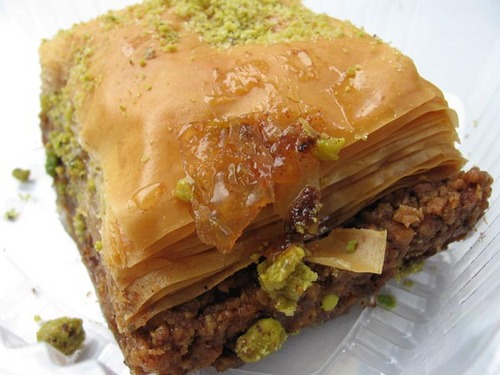
Baklava is usually considered Turkish in origin, but the true beginnings of this rich pastry dessert are actually not very clear, although plenty of information dates it to the Byzantine Empire. Regardless of where it began, the method for creating it remains pretty consistent across the board, given only to variations for the filling based on an individual’s preferences. Layers of butter-brushed phyllo dough are filled with a mixture of nuts, then baked to a golden hue before being drenched in a sweet honey syrup. It’s decadence for certain and not a recipe inclined for a neophyte baker; like I said, I have no interest in ever making it although I am certain that with my agonizing attention to detail and rather obsessive nature, I would likely make a righteous pan of it if the desire ever struck. Thanks, but no thanks. I would rather gaze at photos like the one above and read over someone else’s recipe.
See? I told you it would be short and sweet!

November 16th, 2008
| 1 Comment »
Today is National Fast Food Day but….ewww yuk….I recoiled in near horror when faced with this one. What kind of research would I have to do for this? I never eat fast food, never at all unless it’s a Mavericks pulled pork sandwich done Carolina style, slathered with a little chipotle horseradish and some sweet banana peppers. Now that’s a sandwich. If you reside in the Twin Cities and haven’t been to Mavericks, get yourself over there and enjoy. They also have some of the best french fries ever. Ever. But being that it is pork, it ties in with what I happened to discover about this day over in the tiny gastronomically inclined country of France.
Paging through the current issue of Saveur magazine, I came across a tiny little article in it about a French celebration honoring Saint Anthony, the patron saint of Charcuterie. Subsequent research failed to result in any extensive information about this at all, save for a few bits here and there about how Saint Anthony often was pictured with a pig, but doing a search for St. Anthony only brings up information about the patron saint of the lost, or in another context, the patron saint of skin disease.
Not what I was looking for, actually.
In France each year, on the third Sunday of November (that would be today), it isn’t uncommon for up to a thousand worshippers to gather at the 368-year old Saint-Eustache church located directly across from the where the legendary Les Halles market once stood. The event, the annual Messe du Souvenir des Charcutiers, or Charcuterie Mass of Remembrance is in it’s 200th year and is a solemn affair honoring the nations makers of sausages, hams and pates. The priests sing gregorian chants and incense is thick in the church as scripture readings that promise a heavenly feast of succulent meats and sensuous wines are intoned. A delegation from the Fraternity of the Knights of Saint Anthony is present and there is usually a large contingent of charcutiers in toques and chef whites, some bearing the gold medal of the prestigious Meilleurs Ouvriers de France award, which is given to the most gifted of the nations culinary arts and other trades. The term ‘charcuterie’ is derived from the French ‘chair cuitiers’ or ‘flesh cookers’ and France’s National Charcutier Association dates back to 1513 when those who specialized in cooked, cured and preserved pork products formed their own group away from the butcher’s guild. During the service, the names of those in the association who have passed on are read aloud, and the ceremony concludes with a heart-felt singing of ‘Chant des Adieux’, the French version of ‘Auld Lang Syne’. A reception afterwards features dry cured hams, and headcheeses. In a pamphlet published by the church’s pastor, one is reminded of the purpose of the event, in that it isn’t purely alimentary but “…about providing what responds to our desire for conviviality, for sharing, for good taste, for beauty. Food is not just about taking care of an organic need of the human body”
I’m all for that.
I profess an abiding love for charcuterie although I don’t indulge as often as I would like simple because it’s not the most healthiest item to eat. I am loud in my love for bacon though, the thicker and smokier the better. I love a good hard dry-cured salami like soppresata, but really when it comes down to it, any salami to me is fabulous. I love it best on good dark bread with a smear of grainy mustard; a rare sandwich indulgence for me. But then again, prosciutto in pasta or wrapped around fresh nectarines or melon, ham and bean soup, ham in mac and cheese….it’s all good; salty, briny and fabulous preserved goodness. Now when I indulge I can lift a silent toast to St. Anthony, the patron saint.

Let’s have some in celebration!!
November 15th, 2008
| 5 Comments »
Fifteen posts down for NaBloPoMo and fifteen more to go. So far so good.
Today will be a fun post as it’s National Bundt Pan Day. In Minnesota, we can boast not just the amazing four-season changes in weather coupled with temps that can range over 130 degrees in a single calendar year, but we can brag that Nordicware’s inspired Bundt pan was built and sold from the non-descript factory that stills resides on the south side of Highway 7 in Minneapolis. The pan, created in 1950 by H. David Dahlquist, was designed as a request by the Hadassah Society’s chapter in the Twin Cities who were looking for a sturdy pan to bake a traditional Austrian/German coffee cake called bundkuchen, also known as kugelhopf, or gugelhupf. The sturdy pan made out of aluminum may have been destined for anonymity had a bundt-style cake not won second place in the 1966 Pillsbury Bake-Off; the be all to end all of baking contests. The winning design prompted a mad scramble for the pans, and in 1970, Pillsbury itself licensed the name for a line of cake mixes. It was a meteoric rise for the pans, resulting in an introduction to the Smithsonian Museum in early 2007 and an estimated 60 million pans in kitchens from coast to coast. The fluted and grooved sides of a Bundt pan are considered one of the most recognizable kitchen items ever, and since the inception of the original design, Nordicware has created a multitude of new designs and functions to this once simple pan, including loaf style Bundt pans, miniatures, pans in different shapes and designs such as Fleur-de-Lis, Cathedrals, Hearts, Spirals, Castles, Stadiums, a Pirate Ship and a new Kugelhopf pan specifically for that first ever bundt cake created. There’s holiday style pans depicting pumpkins, snowmen, Christmas trees, wreaths and Santa Claus all created in heavy duty cast aluminum.
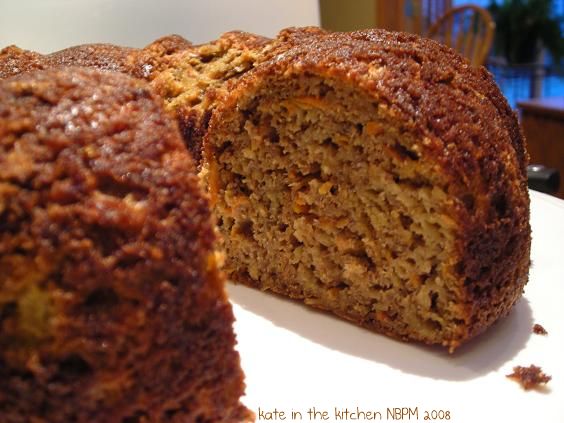
I grew up with bundt cakes and the sight of one always makes me think of my mom. Other than the layer cakes she baked for our birthdays, every cake she made was done in a bundt pan and I can still envision her old dark-orange pan, slightly chipped and worn as she would pull it from the cupboard. After I was on my own and had a decent sized kitchen again, I sought out and purchased a bundt pan for myself as I couldn’t imagine not having one, even if I didn’t use it as much as Mom did. Just being able to pull it out to bake a cake gives me a surge of nostalgia and I always hang on to the bundt cake recipes I come across. I don’t know if it’s just the memories or something else, but no cake tastes quite the same to me like one made in a bundt pan.

This recipe came from Adam at Baking with Dynamite. I like his loose and casual style and he can put up some pretty killer looking posts. What I love about this cake recipe is that it’s not a super overload of oil and eggs and with the addition of apple and carrot it can actually pass for something reasonably good to eat. And of course, it’s just delicious.
Apple Carrot Cake
Recipe by Adam (Baking with Dynamite)
1 cup whole wheat flour
1 cup AP flour
1 tsp baking soda
1 tsp baking powder
1 1/2 tsp cinnamon
1/4 tsp allspice
Pinch (or two pinches if you’re like me) cloves
1/2 cup sugar
1 cup packed brown sugar
3 eggs
1/2 cup canola or neutral flavored oil
1/2 pound carrots, peeled and grated (about 3)
1/2 pound apples, peeled and grated (about 3 small ones)
Preheat your oven to 350*. Grease a large 13×9 pan, or any pan you like. I used a round pan, because I really like round bundt type cakes 🙂 <——my thoughts exactly
In a medium bowl, combine the flours, baking soda and powder, and spices. Stir with a spoon so they are all mixed evenly, and set this bowl aside.
In a large bowl, place the sugars together, and stir with a wooden spoon so they are all mixed up. Add the 3 eggs, and mix well, so they form a nice sugary, liquidy type glaze. Pour in the oil and mix by hand or hand mixer for a few minutes, so they emulsify.
Add the dry flour mixture into the wet sugar one, and mix well. If you are using a wooden spoon, you are going to get a workout on this one. I even had to switch hands, and I rarely ever do that 🙂 The resulting batter is very thick, but don’t worry… it’ll be all better soon. Once the batter is smooth, brown, and no lumps remain, fold in the carrots and apples. I think the moisture from the fruit adds a bit more liquid to the batter, and it becomes much easier to work with.
Pour the batter into your prepared pan, and bake for 30-40 minutes, or until the cake springs back lightly to the touch, and a toothpick comes out clean. Baking times depend on the pan you use. (my bundt pan required an hour of cooking time)

Bake a Bundt!!
November 14th, 2008
| 2 Comments »
It’s National Pickle Day and National Guacamole Day. I suppose since ‘being green’ is the new buzzword phrase that everyone is throwing down- even computer software, which makes me think ‘What the heck is ‘green’ software?’- naturally having a green food day is apropos.
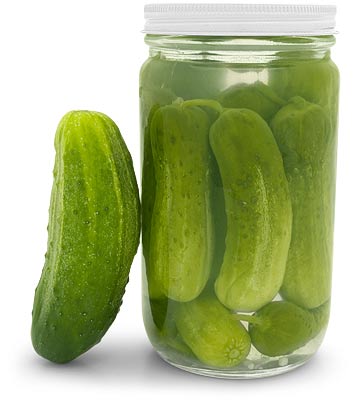 Think pickles and you think cucumbers, you don’t think ‘process’ but pickling is a process and not a food. It’s like saying ‘I need a Kleenex’. Kleenex is a brand, but what you want is a tissue. I know that I’m just comparing apples to oranges and y’all really don’t need to be told this; pickles have undergone that etymology that now means a crisp briny cucumber, not a process of preservation and pickles have become much more mainstream as well. There are companies who produce artisan pickles out of a wide variety of vegetables, honing the art with a fine tooth comb and creating an new legion of fans to all things vinegar. It’s not just about sauerkraut anymore. Think pickles and you think cucumbers, you don’t think ‘process’ but pickling is a process and not a food. It’s like saying ‘I need a Kleenex’. Kleenex is a brand, but what you want is a tissue. I know that I’m just comparing apples to oranges and y’all really don’t need to be told this; pickles have undergone that etymology that now means a crisp briny cucumber, not a process of preservation and pickles have become much more mainstream as well. There are companies who produce artisan pickles out of a wide variety of vegetables, honing the art with a fine tooth comb and creating an new legion of fans to all things vinegar. It’s not just about sauerkraut anymore.
Pickling has been around for 5,000 years and differs from canning in that it does not require the item to be completely sterile before it is sealed. The distinguishing feature of pickling is to produce a pH that is low enough to kill of bacteria; natural fermentation at room temperature, provided by lactic acid bacteria produces this required level. The presence of acid or saline, along with the deprivation of oxygen brings the desired end result. These days, with refrigeration, this means of preservation isn’t as much a necessity as it is a pleasure; people love pickles of any kind. Asian cuisine is renowned for pickled items, most notably kimchi and umeboshi, in Britain you find pickled eggs and onions in many pubs as a snack food, herring is pickled in Scandinavia and we’ve already mentioned sauerkraut. Italian Giardiniera is a very popular dish of pickled vegetables including onions, carrots, celery and cauliflower. Middle Eastern countries serve pickles at almost every meal and of course, in the USA we have pickles galore of every kind, shape, and size- sweet, dill, hot and either crispy or soft; they’re sliced, quartered, whole in all sizes from the tiny cornichons to the gigantic sized pickles on a stick. Olives are pickles, or simply pickled. Okra is a popular pickled item in the South and pickled peppers are found from Italian to Mexican cuisine. Pickling can be considered a dry cure too, such as corned beef, pastrami, lox or even ham.
Had enough of pickles? I’m not a huge fan of them although olives tend to make me weak-kneed; my pickles need to be so crisp that they snap when you bite them and although I can eat the sweet bread-and-butter pickle slices on hamburgers, I prefer dill pickle relish on my bratwurst and fuggedabout sauerkraut. Just fuggedabottit.
On the other hand, guacamole is something I could eat every day.
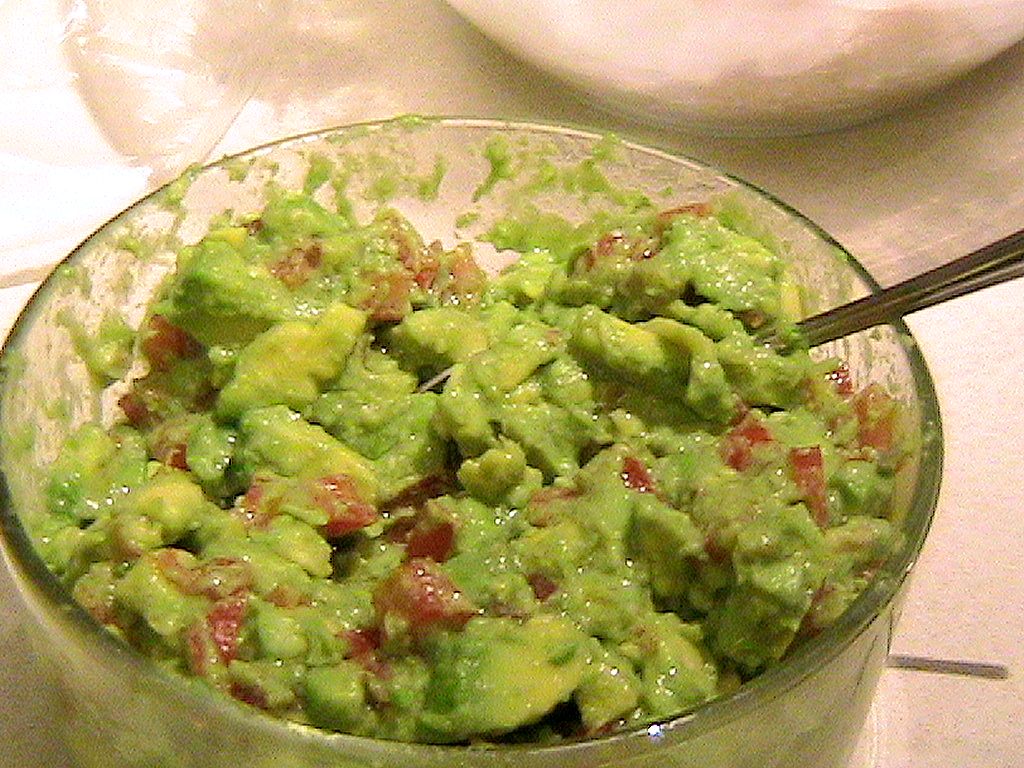
I love a chunkier guacamole as opposed to the smooth version. Traditional Mexican standard ingredients include avocados, minced tomatoes and white onions, plenty of cilantro, lime juice, garlic and salt. Made it in a molcajete or just stirred together in a bowl, it goes with your burrito, taco, enchilada, taquito, chalupa, chimichanga, corn chip or simply on a spoon.
This is how I like to make it: Split three avocadoes and carve into a dice, scooping the flesh into a bowl. Add one seeded and diced tomato, lime zest and juice from half a lime, a rounded teaspoon of kosher salt, half a teaspoon each of cumin and chili powder and a few shakes of garlic and onion powder. I don’t add raw onion or garlic- too strong. Stir to combine and allow to sit for 10 minutes or so before serving.

Enjoy the green today!
November 13th, 2008
| 2 Comments »
When I was researching all these food holidays I recognized all but one of the foods on the calendar and the more I looked over the recipes for this particular item, the more I bounced back and forth between just wanting to talk about it, and wanting to stick my neck out and actually prepare the dish. What actually kicked my over the edge was the one recurring thought hammering in my head; What kind of food journalist would I be if I didn’t leap feet first into my research?
The food in question is Indian Pudding. Today celebrates all the glory of this cornmeal based dish. Never heard of it? You likely aren’t alone; for all the food knowledge I have stuffed in my brain, I wasn’t at all aware of this dish, but then I took a leap, made the recipe and scooped some into a bowl. Call me a true convert.
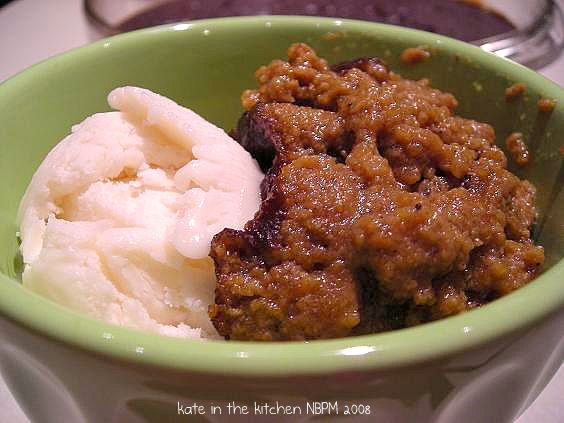
It’s possible that this warm, molasses spiked baked pudding dish solely appealed to me because for every recipe I poured through, it always, always claimed to be best served warm over ice cream. When I was telling Mike about it, he had that familiar look of skepticism on his face until I said ‘You’re supposed to eat it over ice cream.’ then his eyes lit up and he said brightly ‘Say no more!!’ See how we are? Tell us we can eat it with ice cream and we’re SO there.
The history of Indian Pudding isn’t Indian at all. It’s origin is with the new settlers of the Plymouth Colonies. With the increase in the number of cows brought from England, and subsequently, the cows milk, they needed ways to use up the bounty and had the idea of creating a milk-based pudding like they had known in Old England, primarily Plum Pudding. Wheat flour was still scarce and mostly coveted for bread, so the settlers used cornmeal, and being the time that everything involving corn was named for the Indians, the name of the pudding naturally became ‘Indian Pudding’ despite having such non-Indian ingredients in it like molasses, eggs and butter, not to mention spices like cinnamon and nutmeg. But the name stuck.
All the recipes I came across were virtually the same. I went with this one as I can always trust and respect the source.
And the pudding was ridiculously good, and not just because it was nestled next to vanilla ice cream- dairy free, thank you- but because what came out of the oven after the long slow bake was a deeply burnished dish of warm and creamy custard spiked with rich molasses and a hint of cinnamon. I would have been happy to simply spoon up the dreamy goodness all by itself too. I cut the recipe I used in half and am always a bit skeptical of doing, especially in a custard-based dish, but it turned out more perfect than I could have imagined. As I swooned my way through my bowl I thought ‘This needs to be on the Thanksgiving menu!’ and really, it could be on any winter menu for it’s warmth and soothing appeal.

November 12th, 2008
| Comments Off on Food holiday mish-mash
Officially, we’re looking at National Chicken Soup Day and National Pizza with the Works (except Anchovies) Day.
k, thanks…..bye

Oh right, sorry there Chicken, a little humor insert, but that’s the extent of what I feel for these particular days- not a lot of excitement. How can you get excited about Chicken Soup? Or pizza overloaded with too many toppings? Ho hum…
I love Chicken Soup, don’t get me wrong. Little else can soothe so universally as chicken soup, made fresh with lots of vegetables and soft dreamy noodles. It’s a well known fact that it’s good for colds and sinus infections, but whether or not it’s beneficial isn’t always the reason to indulge; eat it because it’s delicious and a simple and healthy option. Soup is such a great way to offer a meal that is low in calories and high in substance; you can add in a multitude of vegetables and easily achieve a large amount of your RDA in vegetable consumption with one meal. A little goes a long way too.
Soup is a much beloved and oft repeated meal in our house and the sky is the limit for what goes into the pot. I didn’t cook up anything new for this post, but here are some of my favorite soups ever- Chicken Tortellini Alfredo Soup, a lively Smoky Chicken Tortilla Soup, and a rich and creamy Chili Blanco, then a completely random but delicious Chicken Corn Potato Chowder. This last one isn’t a chicken soup, but it’s wonderful anyway, and as long as we’re talking soups, you should give this Pesto Vegetable Soup a shot.
And now….Pizza.
I’m a minimalist when it comes to pizza; the less on the crust, the better I like it. I’ve had those Everything Pizza’s and it’s just too much stuff. I’m not a fan of onions on my pizza unless they are beautifully caramelized; mushrooms aren’t a favorite either. I don’t like hamburger on it, or canadian bacon, or pineapple or pickles or jalapenos or cheddar cheese or potato or beets……
All right, those last two might be considered a long shot, but the rest is not. A classic combo that I love is sausage and green pepper; I also love just pepperoni with nothing but cheese. I love chicken, tomato and green pepper, I love fresh tomato and fresh mozzarella, with capers and kalamatas. And I love vegetable pizza. But these days, with dairy being on my avoidance list, pizza has taken a backseat in my culinary repertoire and I seriously miss it. Indulge in a slice or two for me, would you??

November 11th, 2008
| 8 Comments »
You would think that having a national holiday involving ice cream might be a great idea in, say July or some other typically hot month, but no…..it’s November 11th, and along with Veteran’s Day, today is National Ice Cream Sundae Day.
It’s surprising what you come across when you research food holidays, like the official website of the Ice Cream Sundae; an entire page of quotes regarding the time-honored dessert and not one, but two books.
And who knew there was such blazing controversy over the origin and official ‘first served’ status of the ice cream sundae? Despite the arguments and vitriole surrounding it, the hands-down site of the first ever ice cream sundae created is known to be Ithaca, New York. From the website:
“The year was 1892. Ithaca, New York, was dotted with local drug stores, where many a nickel was spent for a dish of ice cream. After Sunday services at the Unitarian Church, Reverend John M. Scott visited the Platt & Colt Pharmacy in downtown Ithaca, New York, for his usual dish of vanilla ice cream — but on one fateful day, history was altered forever. That day, instead of plain vanilla for the Reverend, Chester Platt dipped his scoop of ice cream into a champagne saucer, poured cherry syrup over the top, and dressed it with a candied cherry. As the two men pondered over what to call the delightful new concoction, Scott proposed that it be named after the day on which it was invented: Cherry Sunday”
The controversy stems from Two Rivers, Wisconsin and it’s claim to have served a ‘soda-less’ ice cream treat, that is, ice cream without the fizzy water, and throughout the ensuing years there became quite the rivalry over this; there was an entire segment on the CBS Evening News in 2006 about the ongoing dispute and furor from the Two Rivers town manager at the time who adamantly claimed his town’s right to fame. It didn’t seem to matter to him that a copy of a newspaper in Ithaca, dated April 5, 1892 advertised the now-famous concoction at the now legendary soda fountain, Platt and Colt. Two Rivers has no such documentation, and apparently they aren’t willing to go down without a fight. Can you believe the things some people will argue about?
The best part about examining these holidays is doing the research at home.

As we sat down on a chilly November evening to indulge in ice cream, chocolate, nuts and cookies, we ended up in a friendly familial discussion over what constitutes a Tin Roof Sundae and a Turtle Sundae. Mike thought the Tin Roof was a Turtle with nuts, and Griffin insisted- because he’s 14 and knows everything– that a Turtle was with chocolate, caramel and pecans and a Tin Roof had peanuts. I looked at them both, spooning my ice cream into my mouth and wondered why they wouldn’t just stop debating and eat, for pete’s sake!
It turned out, surprisingly, that Griffin was right.
But a sundae, no matter what you put on it, is the most popular and recognizable of ice cream treats anywhere, I would wager even more so than the ice cream malt. And if you’re ever in a position to fully indulge yourself in a decadent dessert, head to Serendipity 3 Restaurant in New York City for their $1,000 ice cream sundae, composed of the following:
” The Serendipity Golden Opulence Sundae, sold by Serendipity 3 restaurant is a dessert that consists of five scoops of Tahitian vanilla bean ice cream infused with Madagascar vanilla, covered in 23-carat edible gold leaf, rare Amedei Porceleana and Chuao chocolate, American Golden caviar, passion fruit, orange and Armagnac candied fruits from Paris, marzipan cherries, and decorated with real gold dragees. The sundae is served in a baccarat Harcourt crystal goblet with an 18-karat gold spoon “
Or just get some Edy’s, Breyers, or Kemps and make your own delightful creation. Got a favorite combination??? Do share!! I love mint chip ice cream, chocolate sauce and crushed cookies. If you must add whip cream to mine, make it the real stuff!!
“It may be said that ice cream is the best drug available for both mind and body. It is spiritually uplifting, nutritious and wholesome. According to many nutritionists, the calcium in ice cream has a calming effect. A number of psychiatrists, instead of prescribing tranquilizing medication, advise their patients to have some ice cream.”
– Prof. Ralph Slovenko, Journal of Psychiatry & Law
Now that’s MY kind of diagnosis!

November 10th, 2008
| 9 Comments »
If I even begin to think, talk or silently debate about doing one of these next year, somebody smack me and duct tape my arms down until I come to my senses.
But, that being said and with the fresh memory of just exactly how long this whole procedure took, the end result couldn’t help but charm the smile right out of me. It’s pretty darn cute.

Today, in the food-centric month of November, it’s National Gingerbread House Day. It’s also National Vanilla Cupcake Day and I had every intention of making a delicious batch of cupcakes to celebrate but then this house took over my life and squeezed all the motivation out of me over, oh….about six and a half hours. I tried to be sour about the effort and time, but then something happened…….
I couldn’t help but smile at the snowball fight antics of the gummy bears, those mischevious little things.
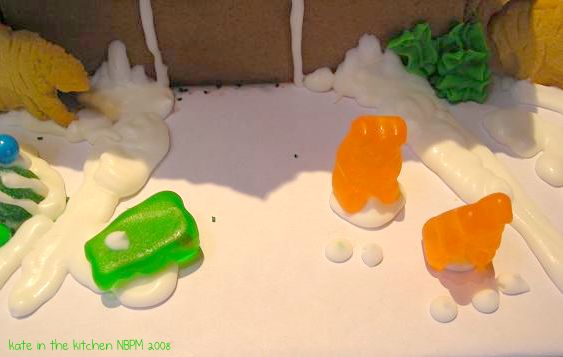
Or appreciate the snow covered Christmas tree in the front yard.

The bears have done such a wonderful job hanging lights and garlands around the house.
 
And the fence was so pretty and festive…..they were just finishing it up too.

And Santa Gummy Bear was lurking on the chimney!

So I tried to be all Grinchy about the effort, the time and the frustration involved in trying to piece together lopsided pre-formed gingerbread pieces with angles that were all off-center and not straight, but really, like childbirth, the final effort was worth all the agony. It is really, really darn cute.
It wasn’t until I started in on the pieces of the ‘ready to decorate’ kit- a colossal lie if I ever read one- that I recalled reading far too much about them on other blog sites last year (and the year before if I really want to admit it) that said these kits were extremely difficult to work with. The intentions are good, absolutely, but it just doesn’t have the ease that one is lead to believe. In my kit, the two side pieces were warped, and no amount of shaping could save them. This meant that every piece that was supposed to attach to them wouldn’t fit either. Maybe they aren’t all as bad as this one; I could hope anyway. While I have a large perfectionist streak that led me to work probably way too long on this to be successful, I think someone with less patience would have given up at first sight. Once I was done with the forming of the house, the last thing I wanted to do was futz with any decorations, in fact, all I wanted was a stiff drink. The only thought that kept me from chucking the lopsided thing in the trash was the recurring mantra ‘It will definitely look better once I decorate it!!!’ and so I sat down with ‘NCIS’ because Mark Harmon can cure any ill-will with those blue eyes, even at his advanced age, and also with my knitting- the finest brain silencer I have ever known- and well, by the time ‘Numb3rs’ came on, the ‘house from hell’ was nearly forgotten.
So FAIR WARNING– skip the kits and find a decent recipe and guide to make a house from scratch, that is, if you truly want to do this. It also works to use graham crackers. I had my cake decorating skills from culinary school to support me, and the tools to make it all work, like piping bags and decorating tips. Even given all that, this may be the only gingerbread house I ever make. Thank goodness I have no plans to eat it so it can sit around and be admired until after Christmas when I can stand 10 feet from the open trash can and launch it inside, ceremoniously and with glee.

Anybody got a cupcake????
November 9th, 2008
| 3 Comments »
I fully intended to get into National Scrapple Day, learn about a new food and tell you all the meritable aspects of it, but what fell onto my plate did little else but make me eye the trash can and wish it was a different food holiday. Sorry about that, but I guess that I can’t be jumping for joy over every one of my NaBloPoMo topics. Looking at the rest of the month, I am crossing my fingers that this one is the worst of the bunch.
Scrapple, for those uninitiated, is arguably one of the first pork foods created in America, owing it’s humble roots to the Pennsylvania Dutch and Appalachia regions of the East Coast and brought about by the age old frugality of rural life where nothing, and I do mean nothing, ever goes to waste. It is composed of pork scraps left over, ideally, from the butchering process and deemed too small to be used elsewhere or sold; the scraps are mixed with water or broth and cornmeal (with additional buckwheat flour on occasion) and cooked into a mush that is then refrigerated until firm and fried in slices. It is a breakfast food, served hot and topped with any number of condiments ranging from ketchup to maple syrup, or it is covered with eggs, mixed with eggs, served on toast, served with toast……you get the picture. Traditional Scrapple is made with pig offal- the head, heart, liver and other bits- boiled with bones and everything still attached to make a broth that has the gelatinous make-up that will chill the mixture firmly. Any seasoning added, like any regional or ethnic offering, is very much the fingerprint of the individual cook, but typical additions are sage, thyme and savory.
I did come across a recipe, and even roasted a nice piece of pork so I could say that I really tried Scrapple, but I’m pretty sure that my rendition was nothing like the original design. That being said, it wasn’t bad; it was like polenta slices with chunks of pork in them and since I have an ongoing love/hate relationship with polenta, it seemed to cloud my judgment of Scrapple. I cooked up two slices, probably too small, we sampled them and the rest went into the trash. So I tried.
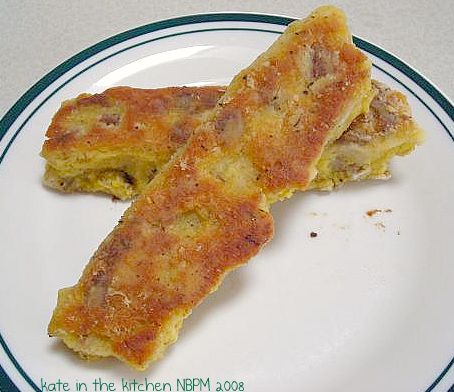
It wasn’t that it was bad; it just wasn’t, well…..in my opinion, it wasn’t that good either. I suppose it could have withstood more bold seasonings, a finer chop of pork, maybe some added onion or peppers, something to make it really pop in the mouth, but the bottom line was simple- it was cornmeal mush and I’m just not your cornmeal mush girl. It’s not something I’m willing to work with.
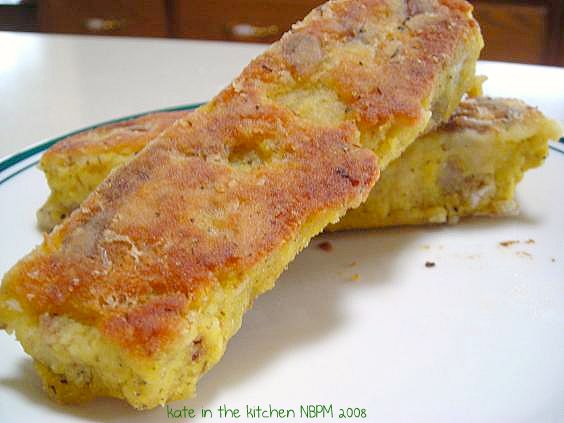
Let’s move on then, shall we??

|
















